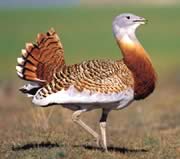 |
| Great Bustard |
A study on the population
trends of wild birds shows the numbers of 24 widespread farmland
birds across Europe, including skylarks,
lapwings and yellowhammers, have crashed by one third since 1980,
because of intensive farming caused by the Common Agricultural
Policy.
These declines have been severest in countries in north-west
Europe. In the UK, for example, intensive agriculture has squeezed
wildlife
out of many former strongholds.
Previous RSPB research has shown that the population declines of
farmland birds have been greatest in those European countries with
the most intensive farming systems. In the UK, between 1970 and
1999, the skylark has declined by 52%, the yellowhammer by 53%
and the corn bunting by 88%.
With 10 countries join the European Union (EU) on 1 May 2004, 25
European members of BirdLife International, including the RSPB,
are calling on the European Commission and governments of member
and accession states to put the environment and wildlife at the
heart of farming policy. Otherwise, the coalition says, wildlife
and the environment will continue to suffer.
Of around 453 species of bird occurring regularly in Europe, 150
(about one third) rely on sustainable farming for their future
survival. Birds at most immediate risk are those that are particularly
vulnerable to intensive agriculture, such as the corncrake, the
red-backed shrike and the great bustard.
Birds that have already been lost as regular breeding birds from
England and much of north-west Europe could now be threatened by
agricultural development elsewhere in Europe, particularly the
countries joining in May. Currently, eastern European states outside
the EU have significant populations of these birds.
| Birds at most immediate risk are those that are particularly
vulnerable to intensive agriculture, such as the corncrake,
the red-backed shrike and the great bustard |
BirdLife International says it is vital that governments of the
10 countries joining the EU in May heed this stark warning. Otherwise,
BirdLife warns, there will be further massive declines or even
extinctions of wildlife that relies on Europe's farmed landscapes.
Speaking ahead of a conference in Berlin about this subject, the
RSPB's chief executive, Graham Wynne, explains: 'For more than
three decades the wildlife of the European Union has been ravaged
by agricultural production subsidies encouraging intensive farming
ahead of sustainability and the environment.
'Governments of the newest members to join the EU must learn the
lessons from countries like the UK, where declines of farmland
wildlife have seen once common species, like the tree sparrow and
lapwing, disappear from many areas. They should use EU financial
support to maintain farming systems which respect environmental
limits and leaves room for wildlife.'
Graham Wynne continues: 'The decline of the corncrake has been
one of the most obvious effects of the industrialisation of farming
across Europe. Subsidies paid to farmers to maximise output have
driven the corncrake out of much of the European Union. In fact,
this has been so marked you can pick out the outline of the Common
Agricultural Policy imprinted on the distribution map of the bird.'
19 January 2004 courtesy of 
|



